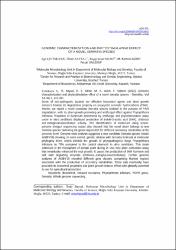GENOMIC CHARACTERIZATION AND PHYTOSTIMULATIVE EFFECT OF A NOVEL SERRATIA SPECIES
Citation
Çetinkaya, A., Ö. Baysal, R. S. Silme, M. K. Azim, and F. Saleem. 2022. "GENOMIC CHARACTERIZATION AND PHYTOSTIMULATIVE EFFECT OF A NOVEL SERRATIA SPECIES." Genetika 54 (1): 341-367. doi:10.2298/GENSR2201341CAbstract
Some of non-pathogenic bacteria are effective biocontrol agents and plant growth inducers besides its degradative property on polycyclic aromatic hydrocarbons (PAH). Herein, we report a novel candidate Serratia species isolated in the purpose of PAH degradation, with its plant-growth-promoting and antifungal effect against Phytophthora infestans. Properties of bacterium determined by antifungal and phytostimulation assay under in vitro conditions displayed production of indole-3-acetic acid (IAA), chitinase and endoglucanase/cellulase activity. The identification of bacterium using whole-genome shotgun sequencing output also showed that the novel strain belongs to new Serratia species harboring the genes responsible for different secondary metabolites at the genomic level. Genome-wide analysis suggested a new candidate Serratia species (strain AGBY19) showing, in some extend, genetic relation with Serratia fonticola at molecular phylogeny level, which inhibits the growth of phytopathogenic fungi Phytophthora infestans by 73% compared to the control observed in vitro conditions. This strain colonised at the rhizosphere of tomato plant during in vivo host plant cultivation assay that remarkably enhanced the root growth. It causes the production of IAA hormone and cell wall degrading enzymes (chitinase, endoglucanase/cellulase). Further genome analyses of AGBY19 revealed different gene clusters comprising flanked regions associated with the production of secondary metabolites. These data eventually have provided its biocontrol properties and plant-growth inducer effect with globally potential to use for agricultural production


















